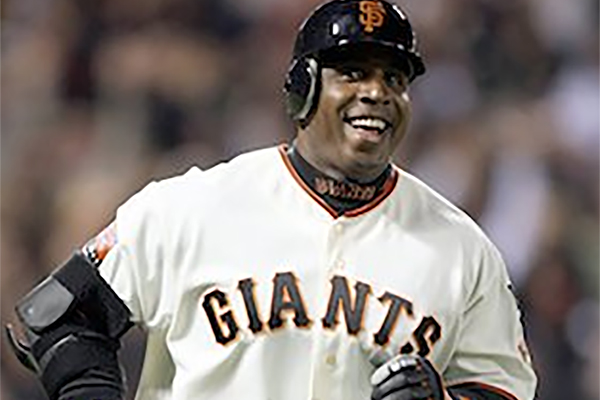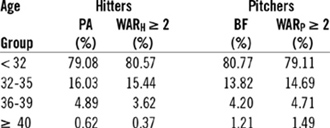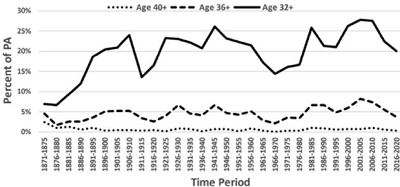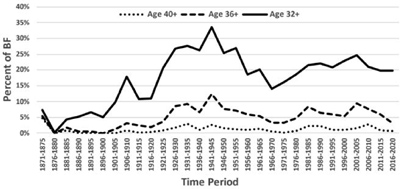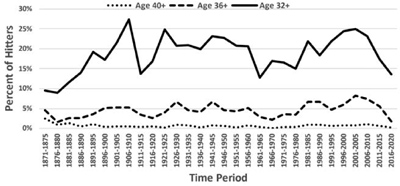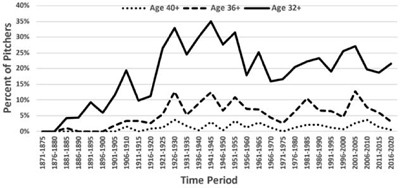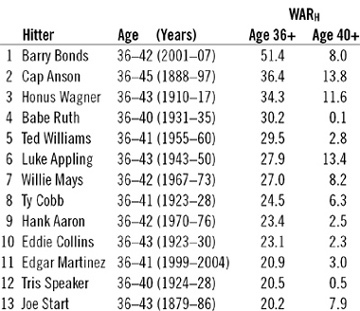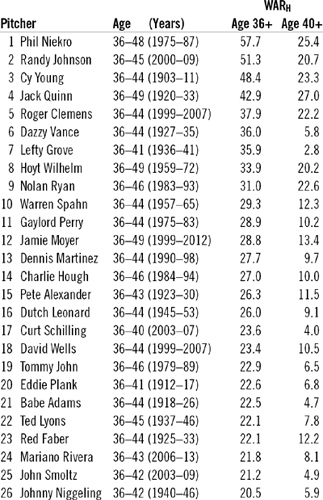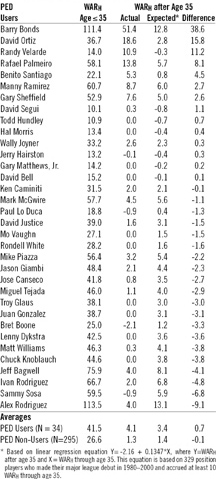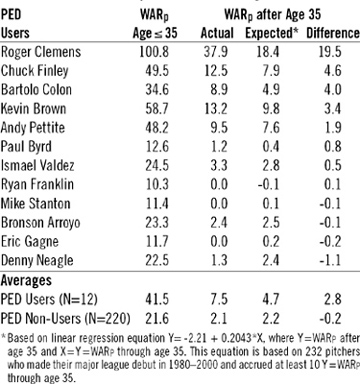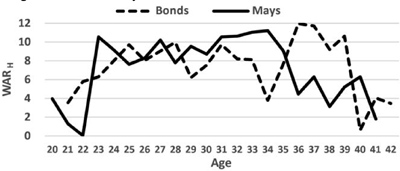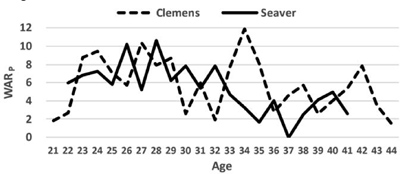Did Performance-Enhancing Drugs Prolong Careers?
This article was written by David J. Gordon
This article was published in Fall 2021 Baseball Research Journal
Although the last decade of the Steroid Era was associated with an increase in the number of players sustaining productive MLB careers beyond age 32 — including Barry Bonds, who set a single-season record with 73 home runs in 2001 at age 36 — it is not clear that PEDs were actually responsible for this increase. (MLB.COM)
The 27-year span from approximately 1987 to 2013 is popularly called the “Steroid Era” because of the purportedly rampant use of performance enhancing drugs (PED), specifically anabolic steroids and (to a lesser extent) human growth hormone (HGH). Although steroid use in MLB dates as far back as Pud Galvin in 1889, the body-builder physique that steroids produce had previously been thought to impair the flexibility required for baseball rather than provide a competitive edge.1 The use of illegal stimulants like amphetamines to gain an edge was commonplace before 1987, but did not create a stir because they did not bring about “unnatural” changes in body configuration and strength.2
Steroid use in baseball first gained visibility when Annie Leibovitz published photos of a shirtless Jose Canseco in Vanity Fair during his 40–40 season in 1988. Canseco’s sculpted physique raised eyebrows. Concerns grew with a spate of 50-home-run seasons in the 1990s, capped by the epic Mark McGwire-Sammy Sosa race past Roger Maris’s home-run record in 1998, and culminated with Barry Bonds’s allegedly steroid-fueled late-career power surge in 2001–04.3
The impact of PED use was reflected most visibly in the home run totals of hitters who used them.4 The 50-home-run threshold had previously been reached or surpassed only 17 times in the first 70 years of the “live-ball” era (1920–89) — four times by Ruth, twice each by Jimmie Foxx, Ralph Kiner, Mickey Mantle, and Willie Mays, and once each by George Foster, Hank Greenberg, Maris, Johnny Mize, and Hack Wilson.5 However, the 50-home-run threshold was reached or exceeded 29 times in 30 years (1990–2019) by 20 players (including four times each by McGwire and Sammy Sosa), and the 60-home-run threshold was exceeded six times — by Sosa (3), McGwire (2), and Bonds.
Twenty-three of these 29 post-1989 50-home-run seasons occurred between 1995 and 2007; at least 13 of them were generated by known steroid users. Bonds hit more than 40 homers only two times (46 in 1993, 42 in 1996) before he supposedly began using steroids in 1999; he did so five times in 2000–04 at ages 35–39.
Apart from the undeniable effect of anabolic steroids on muscle mass and strength, which was responsible for the proliferation of 50-home-run seasons, the remarkable late career success of noted PED accusees Barry Bonds and Roger Clemens — who remained elite players in their late 30s and played through age 42 and 44, respectively — spawned a secondary narrative that PED use also prolonged careers.
In a 2018 retrospective, Ben Lindbergh wrote, “There’s the unusual aging profile that set that period apart, which would be consistent with the belief that steroids could aid in recovery. McGwire was in his age 34–35 seasons when he hit 70 and 65 bombs in back-to-back years; Barry Bonds was 37 when he hit no. 73. Their atypical aging pattern mirrored the overall major league landscape, which, when weighted by WAR, was heavily skewed toward oldsters to a greater degree than at any other time since the introduction of the DH.”6
Analyst Bill James went even further: “One of the characteristics of the steroid era was that we had several dozen players who continued to improve beyond the normal aging time frame, so that many of them had their best seasons past the age of 32. This is historically not normal. In the post-steroid era we are returning to the historic norm in which players hit a wall sometime in their early thirties. But what does this mean? It means that steroids keep you young.”7
James provided no specific evidence for this startling conclusion, which drew considerable criticism, as did his prediction that by 2040–50 the normalization of anti-aging drugs will open the Hall of Fame gates wide for Bonds, Clemens, et al.8 Only time will tell whether the latter prediction holds water, but we need not wait until 2050 to assess the premise that performance enhancing drugs arrest or reverse the deterioration of baseball skills with advancing age. In this article, I will present an in-depth historical analysis of how the age distribution of MLB players has changed throughout its history and will attempt to gauge the possible impact of PED on career longevity. Specifically, I will address two questions:
- Was the average career longevity in the Steroid Era historically unprecedented, as Bill James claimed?
- Were PED users more likely to remain productive into their late 30s and 40s than their non-PED-using contemporaries?
METHODS
These analyses encompass the following seven organizations: the National Association (1871–75), National League (1876–2020), American Association (1882–91), Union Association (1884), Players League (1890), American League (1901–2020), and Federal League (1914–15). (Data from the Negro Leagues are not yet sufficiently complete to include here.)
I have analyzed the age distribution of playing time — plate appearances (PA) for hitters and batters faced (BF) for pitchers — using the 2020 version of Lahman’s Baseball Database, which is complete through the 2019 season. I added 2020 PA and BF data from Baseball-Reference.com.9,10 I have analyzed the age distribution of WAR for hitters (WARH) and pitchers (WARP) using Baseball-Reference’s STATHEAD analytic tool to count the numbers of players with WAR≥2.0 in different age groups in 5-year intervals and to prepare historical lists of players with the most WAR accrued starting at ages 32, 36, and 40.11
For the purpose of my analysis of players who debuted between 1980 and 2000, I have defined PED to include anabolic steroids and human growth hormone (HGH), but not amphetamines and similar stimulants (which were in use long before the Steroid Era). PED users were defined as players who tested positive at any time for steroids, HGH, or masking agents (including leaked 2003 results), players who admitted (or whose spouses admitted) they used PED, and players implicated in the Mitchell Report or the Biogenesis Anti-Aging Clinic investigation.12,13 I have also included three players (Bagwell, Piazza, and Ivan Rodriguez) whose Hall of Fame election was delayed by circumstantial evidence of PED use. Presumed PED users are listed in Tables 4–5 below.
Linear regression analyses relating WAR after age 35 (dependent variable) to purported PED use and WAR through age 35 (independent variables) were performed using the LINEST function in Microsoft Excel. Position players and pitchers were analyzed separately. Tests of statistical significance were based on the z-score (slope divided by its standard error) of the regression coefficient for PED use.
RESULTS
To establish a framework of what is “normal” in baseball, let us begin by looking at the age distribution of the nearly 17 million pitcher-batter confrontations and the nearly 20,000 2-WAR seasons in the seven organizations identified 1871–2020 (Table 1). I have taken 2 WAR (Baseball-Reference version) as indicative of a solid everyday player or member of his team’s pitching rotation.14
Table 1. Distribution of Playing Time and 2-WAR Seasons by Age (1871–2020)
Ben Lindbergh and Bill James were quite correct in characterizing baseball as a game for young men. Historically, roughly 80% of all PA and BF have gone to players under 32 years of age. Only 5.4% of PA and BF have gone to players over age 35. Although there are almost twice as many age 40+ pitchers as age 40+ hitters (1.2% versus 0.6%), both are rare. Similarly, roughly 80% of all 2-WAR seasons belong to players under age 32. While pitchers are more likely than hitters to hold their value beyond age 35, only 6% of 2-WARP seasons (versus 4% of 2-WARH seasons) occur after age 35.
So how does the Steroid Era compare to these historical norms? The percentage of PA and BF going to players at or above age 32, 36, and 40 are plotted in five-year intervals from 1871–2020 in Figures 1 and 2.
Figure 2. Trend in Age Distribution of BF (Pitchers)
The age distributions for hitters and (to a lesser extent) pitchers did indeed skew somewhat older in the height of the Steroid Era (1996–2010) relative to the preceding or subsequent decades. But the broad historical trend is complex. First, there is a long-term linear trend toward gradually increasing prevalence of older players over time, especially in 1871–1925, paralleling the increase in life expectancy in US males from 42 to 58 years during this 54-year period.15
Second and not surprisingly, the MLB population appeared to skew older in the war years (1941–45) and younger in periods of expansion. Third, the 1996–2010 “steroid peak” is but one of many peaks in the prevalence of older players and is not necessarily even the highest peak. The percentage of BF going to pitchers aged 32 and older was higher in 1926–55 than during the Steroid Era.
While the percentage of PA going to batters aged 32 and older reached an all-time high in 1996–2010, it was relatively low earlier in the Steroid Era in 1986–95. Also, the difference between the 1926–55 and 1996–2010 distributions of PA is consistent with the underlying temporal trend toward an increase in older players.
Figure 3. Age Distribution of Hitters with WARH ≥ 2
Figure 4. Age Distribution of Pitchers with WARP ≥ 2
While Figures 1–2 show that the Steroid Era was associated with only a small increase in the playing time going to older players, the quality of these older players is addressed in Figures 3 and 4, where the proportion of players with Baseball-Reference WAR≥2 in the 32+, 36+, and 40+ age groups is plotted over the course of MLB history.
Again, while the proportion of solid everyday regulars and rotation starters contributing after they turned 32 was higher 1991–2010 than in the decades immediately preceding or following this period, there have been other times in MLB history when this proportion was even higher: 1906–10 and 1921–25 for hitters and 1921–55 for pitchers. The data again suggest a possible PED bump but nothing more. The extreme scarcity of older nineteenth-century pitchers with WARP≥2, which almost certainly reflects attrition due to extreme (400–700 IP) annual workloads, is also noteworthy.
Let us now look more closely at the 13 hitters (Table 2) and 26 pitchers (Table 3) who accrued at least 20 WAR after age 35. I chose age 35 as a cutoff, since there are too many players (125 hitters and 91 pitchers) with at least 20.0 WAR after turning 32 to list here and very few (no hitters and seven pitchers) with at least 20.0 WAR in their 40s. You can find the post-age 40 WAR of these players in the far-right column.
Table 2. Hitters with ≥ 20 WARH After Age 35
Table 2 is dominated by elite Hall of Famers, who were exceptional in their 20s and early 30s as well as after age 35. These hitters were not immune from aging — their declines merely started from a very high performance level. The only non-Hall of Famers listed are Bonds and Joe Start, who was born too early (1842) to play in the majors until age 33. Table 3 is more diverse.
While Table 3 also includes several Hall of Famers (Randy Johnson, Young, Vance, Grove, Ryan, Spahn, Alexander, Rivera, etc.), they are joined by a similar number of knuckleballers (Niekro, Wilhelm, Hough, Leonard, Lyons, Niggeling), spitballers (Quinn, Perry, Faber), and others (Moyer, John) who relied more on guile than power and whose longevity derived from the minimal wear and tear on their pitching arms. Bonds and Clemens are the only suspected PED users with more than 20 WAR after age 35. The only other PED user with ≥15 WAR after age 35 is David Ortiz (18.6), whose only (rumored) positive PED test was in 2003 at age 27. Rafael Palmeiro (13.8), Nelson Cruz (13.3), Bartolo Colon (13.2), Andy Pettitte (12.5), and Randy Velarde (10.9), were the only other PED users with more than 10 WAR after age 35.
Our analyses thus far have looked broadly at historical trends in which the impact of PED is diluted by the far larger numbers of non-users. After all, as far as we know, steroids and HGH gained a foothold in MLB only in the late 1980s and even then were used by a minority of players. Only 5–10% of players were documented as using PEDs when MLB introduced random drug testing in 2003, and we have no hard evidence that the prevalence of PED use ever exceeded that level.16 The next two tables represent a deeper dive into the players of the Steroid Era whose careers began in 1980–2000 and who accrued at least 10 WAR through age 35. (The 2000 cutoff was chosen to exclude all players whose careers are unfinished.)
Table 3. Pitchers with ≥ 20 WARP After Age 35
Table 4 compares the average WARH accrued through and after age 35 by the 33 position players strongly suspected of PED use versus 296 position players not strongly suspected of PED use. On the average, the 33 PED users accrued more WARH (4.3 versus 1.3) than non-users after age 35, but they had also accrued more WARH (42.0 versus 26.6) through their age 35 seasons. Thus, the PED users — at least the ones we know about — were in general more productive through age 35 than non-users, although one cannot be certain whether this was because they used PEDs or whether they were just better players in the first place.
In either case, if one wants to focus specifically on the anti-aging effect of PEDs, one must statistically adjust for the fact that players who were most productive in their 20s and early 30s were most likely to remain productive after age 35. This adjustment was done by using regression analysis to predict post-age 35 WARH as a linear function of WARH through age 35 (Table 4) and subtracting this number from the player’s actual post-age 35 WARH. After this adjustment, the average difference between PED users and non-users shrinks to 0.85 WARH (0.8 versus -0.1) and is not statistically significant (Z=1.32, P=0.19). Indeed, when Barry Bonds (who is something of an outlier) is removed from the regression analysis, PED use is associated with only a 0.26 increment in WARH after age 35 than non-users (Z=0.28, 2-sided P=0.78).
Table 4. Position Players Suspected of PED Use — Actual versus Expected WARH After Age 35
(Click image to enlarge)
Table 5 shows the result of a similar analysis of the 232 pitchers who made their MLB debuts in 1980–2000 and accrued at least 10 WARP through their age 35 season. The adjusted post-age 35 productivity of the 12 such pitchers who were strongly suspected of PED use was compared to that of the 220 such pitchers who were not considered PED users before and after statistical adjustment for the WARP through their age 35 season.
Table 5. Pitchers Suspected of PED Use — Actual versus Expected WARP After Age 35
(Click image to enlarge)
The impact of PED use on WARP after age 35 for pitchers was greater than that for position players, but fell slightly short of statistical significance. The 5.4 unadjusted difference in WARP after age 35 (7.5 versus 2.1) between the 12 PED users and the 220 non-users fell to 3.0 (2.8 versus -0.2) after statistical adjustment for WARP through age 35. Linear regression analysis, adjusted for WARP through age 35, showed that PED use was associated with a 3.0 increment in WARP after age 35 (Z=1.82, 2-sided P=0.07). When Clemens is removed from this analysis, PED use is associated with only a 1.67 higher WARP after age 35 than non-users (Z=0.96, 2-sided P=0.34).
Like many elite players, Bonds and Clemens are clearly outliers; there is little statistical evidence beyond these two players that alleged PED use broadly increased WAR after age 35. Since we cannot find good matches for Bonds and Clemens among their contemporaries, comparing the career WAR trajectories of Barry Bonds (Figure 5) and Roger Clemens (Figure 6) to two players of earlier eras (Willie Mays and Tom Seaver) with similar early career WAR trajectories is illuminating.
Figure 5. Bonds versus Mays
Figure 5 compares the annual season-by-season progression of WARH for Mays and Bonds. The two players performed similarly in their 20s. Mays then outperformed Bonds for ages 30–33. Bonds is assumed to have begun using anabolic steroids at age 34 (1999), but missed two months with an injury.17 The 36– 39-year-old steroid-enhanced version of Bonds far outperformed the 36–39-year old Mays. However, the two men performed similarly in their 40s, and their careers ended at about the same age.
Similarly, Figure 6 compares the annual season-by-season progression of WARP for Seaver and Clemens as a function of age. The two pitchers performed very similarly through age 33. Then, at ages 34–35, when Seaver was fading, Clemens suddenly surged to successive Cy Young awards. According to Kurt Radomsky’s testimony, Clemens used PEDs in his 8.5-WARP age 35 season (1998), but we can only guess whether he also used PEDs in his 11.9-WARP age 34 season (1997).18 In contrast to the Bonds-Mays comparison, Clemens outlasted Seaver and accrued 12.8 WARP at ages 42–44, after Seaver had already retired. But Clemens did not outlast some other great power pitchers, like his contemporaries Nolan Ryan and Randy Johnson, or the man (Cy Young) whose award he won seven times (Table 3).
DISCUSSION
Let us now return to answer the two questions asked at the end of the introduction.
1. The proportion of players who remained active and productive beyond their early 30s was indeed higher during the Steroid Era than in many preceding periods but was not historically unprecedented (Figures 1–4). Specifically, older pitchers — led by knuckleballers, spitballers, and other finesse pitchers — were more prominent in 1925–55 than at any time during the Steroid Era.
2. Although the Steroid Era data suggest that PED users tend to have outperformed non-users after age 35, this effect is modest at best and not statistically significant. The data are somewhat more convincing for pitchers than hitters, but the numbers are small and influenced by outliers like Bonds and Clemens. Moreover, due to the absence of a testing regimen before 2004, our information on who actually used PED and when exactly did they use them is incomplete and somewhat unreliable.
Performance-enhancing drugs are but one of many potential contributors to the historical fluctuation of the age distribution of MLB playing time, before, during, and after the Steroid Era. Other potential contributors include:
- Pitcher usage patterns: Nineteenth century pitchers, who routinely pitched 400–700 innings per season, rarely lasted into their mid-30s. The five pre-Cy Young pitchers who accrued at least 65 WARP — Tim Keefe, John Clarkson, Pud Galvin, Jim McCormick, and Old Hoss Radbourn — accrued a combined total of 0.5 WARP after age 35; none pitched an inning after age 36.
- Improved general health and life expectancy: The mean life expectancy at birth for US males varied between 40 and 45 years in 1870–90.19 Although this statistic was heavily influenced by high mortality rates in infancy and early childhood, a 40-year-old nineteenth century player was still much older biologically than a modern 40-year-old player. Indeed, Clarkson (47), Galvin (45), and Radbourn (42) were all dead by age 47, an age at which Phil Niekro, Jack Quinn, Hoyt Wilhelm, and Jamie Moyer were still getting major league hitters out. As life expectancy has increased by 35 years between 1870 and 2020, it is not surprising that the prevalence of older players has gradually trended upward.20
- Improved medical and surgical techniques: For example, before Dr. Frank Jobe operated on Tommy John in 1974, a torn ulnar collateral ligament spelled the end of a pitcher’s career.
- Expansion: The prevalence of older players has tended to dip when there was a sudden influx of younger players to staff the new teams. This was most apparent when the Federal League was established in 1914 and eight new teams were abruptly added to the existing 16, but expansion may have also contributed to the drop in prevalence of older players in the 1960s and 1970s.
- World War II: The proportion of playing time allocated to older players spiked in 1942–45 when many younger players were serving in the military. However, this mid-century spike cannot be attributed solely to the war, since this proportion had been increasing since the mid-1920s and remained elevated into the 1950s.
- Long-term free agent contracts: Dave Cameron has suggested that the sharp decline in the proportion of playing time allocated to older players in 2011–20 may reflect MLB owners’ growing aversion to offering multi-year deals to older free agents, more than the waning of the Steroid Era.21
While PED usage may have been a contributing factor in the higher-than-normal prevalence of older players in 1995–2010, their impact is modest at best. PED clearly made hitters better, but did not demonstrably prolong their careers. Barry Bonds’s production spiked in his late 30s because that is when he had settled into an optimal conditioning program using “the cream” and “the clear.” But his performance declined in his 40s just as Mays’s performance had declined after he turned 40 in 1971. Lesser players like McGwire and Sosa, who probably used anabolic steroids throughout their careers, were less productive after age 35 than players who did not use PEDs (Table 4).
Pitchers are a bit different because their careers are often limited by the wear and tear on specific muscle groups and ligaments in their pitching arm and shoulder. HGH, which is said to promote recovery and healing without necessarily building muscle mass, features more prominently in the regimen of pitchers than of hitters who used PEDs. Still, aside from Roger Clemens, there is little statistical support for the proposition that PED users were more likely than non-users to remain productive after age 35 (Table 5).
The analyses in Tables 4–5 are of course not definitive, since we do not know for sure exactly who used PEDs, which drugs they used, and how long they used them. For example, I included Jeff Bagwell, who used androstenedione in 1995–97 when it was legal, but for whom the record gets murky after 1997. I did not include players who were the subject of uncorroborated steroid rumors after outlier seasons, like Brady Anderson (1996) and Luis Gonzalez (2001). Admittedly, our classification of PED users and non-users represents only best guesses based on public information.
One might argue that any association of career length with PED use could be at least partly attributable to the increasing likelihood of getting caught using PEDs the longer a player uses them. On the other hand, some players whom I counted as PED users (Sosa, Ortiz) may have stopped using them after testing protocols and penalties were implemented in 2004, so we really don’t know whether PEDs could have prolonged their careers. Sammy Sosa’s performance, for example, declined precipitously in 2003–05 (ages 34–36) after routine testing was implemented, while Ortiz’s performance took off during those years.
It is noteworthy in this vein that the prevalence of productive older players was higher in 2006–10, after testing protocols and penalties were in place, than in 1990–2000, when players were able to use PEDs with impunity. If PED use actually lengthened careers, one would have expected this effect to have diminished after 2004, when it became increasingly difficult for PED users to stay on the field — let alone remain productive — as they aged. For example, the late career productivity of Alex Rodriguez and more recently Robinson Cano were ruined by lengthy suspensions.
As a retired physician, I cannot help but comment here on the irresponsible marketing of anabolic steroids and HGH as “fountain of youth” or “anti-aging” drugs.22 Indeed, the latter term even appears in the name of the Biogenesis Anti-Aging Clinic, which provided steroids to Alex Rodriguez and others 10 years ago.
The legitimate use of testosterone and HGH to treat patients with low testosterone levels and pituitary deficiency, respectively, does not imply that they mitigate or delay the effects of aging or prolong life or justify their use by healthy young athletes. Just as insulin injections, which are life-saving in diabetes, would be dangerous and even lethal in persons without diabetes, anabolic steroids can be dangerous when misused.23
Natural steroid supplements have gotten a partial pass from the US Food and Drug Administration (FDA), which requires only evidence of safety, not efficacy. However, the FDA has not endorsed the safety of the synthetic anabolic steroids that young athletes have injected, applied topically, or ingested in unapproved over-the-counter supplements to add muscle mass, and has warned of the potential for addiction, serious liver and kidney injury, severe acne, hair loss, irritability, increased aggression, depression, heart attack, stroke, deep vein thrombosis, and pulmonary embolism.24
The wrecked lives and early deaths of steroid-abusing athletes Ken Caminiti and Lyle Alzado attest to the danger of these drugs and the falsity of steroids’ promise of eternal youth.25, 26
In conclusion, although the last decade of the Steroid Era was temporally associated with a modest increase in the number of players sustaining productive MLB careers beyond age 32, it is not clear that PED were actually responsible for this increase. While rigorous training regimens incorporating anabolic steroids undoubtedly helped many players of the Steroid Era build muscle mass and strength and thereby attain inflated home run totals at all stages of their careers, there is no convincing evidence that they slowed the inevitable decline associated with aging.
DAVID J. GORDON, MD is a retired biomedical scientist. He has previously published three articles in the BRJ, on the Deadball Era, Racial Equity in the Hall of Fame, and Competitive Balance in MLB. Dr. Gordon is also the author of a book called Baseball Generations, published in 2021.
Notes
1. Christopher Klein, “Baseball’s First Fountain of Youth,” History.com, 2012. https://www.history.com/news/baseballs-first-fountain-of-youth; Joe Halverson, “Pud Galvin: The Godfather of Juicing,” Bleacher Report, undated, https://bleacherreport.com/articles/573866-pud-galvin-thegodfather-of-juicing.
2. Zachary D. Rymer, “Full Timeline of MLB’s Failed Attempts to Rid the Game of PEDs.” Bleacher Report, June 10, 2013. https://bleacherreport.com/articles/1667581-full-timeline-of-mlbs-failed-attempts-to-rid-thegame-of-peds.
3. Jose Canseco images, Bing image search performed Ocotober 11, 2021. https://www.bing.com/images/search?q=Jose+Canseco+Muscles&FORM=IRBPRS&=0.
4. B.J. Erickson, A. Yanke, B. Monson, A. Romeo, “The Effect of the Steroid Era on Major League Baseball Hitters: Did It Enhance Hitting?” Journal of Sports Medicine, Doping Stud 5: 161. doi:10.4172/2161-0673.1000161, https://www.hilarispublisher.com/open-access/the-effect-of-the-steroid-era-on-major-league-baseball-hitters-did-it-enhance-hitting-2161-0673-1000161.pdf.
5. Baseball-Reference.com, “Single-season leaders and records for home runs,” https://www.baseball-reference.com/leaders/HR_season.shtml.
6. Ben Lindbergh, “How much of a role did steroids play in the Steroid Era?” The Ringer, September 28, 2018, https://www.theringer.com/mlb/2018/9/28/17913536/mark-mcgwire-sammy-sosa-steroid-era-home-run-chase.
7. Bill James, “Cooperstown and the ‘Roids,” Bill James Online, 2009, https://www.billjamesonline.com/article1160.
8. Jeb Stewart, “A response to Bill James’ ‘Cooperstown and the ‘Roids,’” The Baseball Chronicle 2009, http://thebaseballchronicle.com/essays/response_to_bill_james.
9. Sean Lahman, Download Lahman’s Baseball Database, http://www.seanlahman.com/baseball-archive/statistics.
10. Baseball-Reference.com, https://www.baseball-reference.com.
11. Stathead Baseball, https://stathead.com/baseball.
12. George J. Mitchell, 2007. “Report to the Commissioner of Baseball of an Independent Investigation into the Illegal Use of Steroids and Other Performance Enhancing Substances by Players in Major League Baseball,” http://mlb.mlb.com/mlb/news/mitchell.
13. Michael Solomon, “The Biogenesis scandal explained,” The Guardian, August 2, 2013, https://www.theguardian.com/sport/2013/aug/02/biogenesis-peds-scandal-explained.
14. Baseball-Reference.com WAR Explained, https://www.baseballreference.com/about/war_explained.shtml.
15. Life Expectancy 1850-2000, University of Oregon, Mapping History: https://mappinghistory.uoregon.edu/english/US/US39-01.html.
16. Jack Curry and Jere Longman, “Results of steroid testing spur baseball to set tougher rules,” The New York Times, November 14, 2003, https://www.nytimes.com/2003/11/14/sports/results-ofsteroid-testing-spur-baseball-to-set-tougher-rules.html.
17. Mark Fainaru-Wada and Lance Williams, Game of Shadows. Gotham Books, New York, 2006.
18. Frederick C. Bush, “Roger Clemens,” SABR BioProject. https://sabr.org/bioproj/person/b5a2be2f.
19. Life Expectancy 1850-2000, University of Oregon, Mapping History: https://mappinghistory.uoregon.edu/english/US/US39-01.html.
20. Macrotrends, US Life Expectancy 1950-2020, https://www.macrotrends.net/countries/USA/united-states/life-expectancy.
21. Dave Cameron, “The other big change in MLB’s post-PED era,” Fangraphs, February 4, 2016, https://blogs.fangraphs.com/the-other-big-changein-mlbs-post-ped-era.
22. Harvard Medical School, “Human growth hormone and the search for the fountain of youth,” Harvard Health Publishing, January 2015, https://www.health.harvard.edu/drugs-and-medications/humangrowth-hormone-and-the-search-for-the-fountain-of-youth.
23. National Institute on Drug Abuse, “Anabolic Steroids DrugFacts,” https://www.drugabuse.gov/publications/drugfacts/anabolic-steroids.
24. FDA Consumer Updates, “Caution: Body-building products can be risky,” https://www.fda.gov/consumers/consumer-updates/caution-bodybuilding-products-can-be-risky.
25. Paul E. Doutrich, “Ken Caminiti,” SABR BioProject, https://sabr.org/bioproj/person/ken-caminiti.
26. Mike Thomas, “Lyle Alzado’s tragic story of lies, steroids, and his untimely death at age 43,” Sportscasting, June 6, 2020, https://www.sportscasting.com/lyle-alzados-tragic-story-of-liessteroids-and-his-untimely-death-at-age-43.



